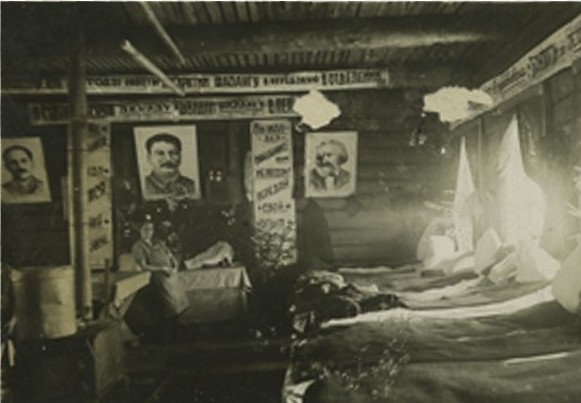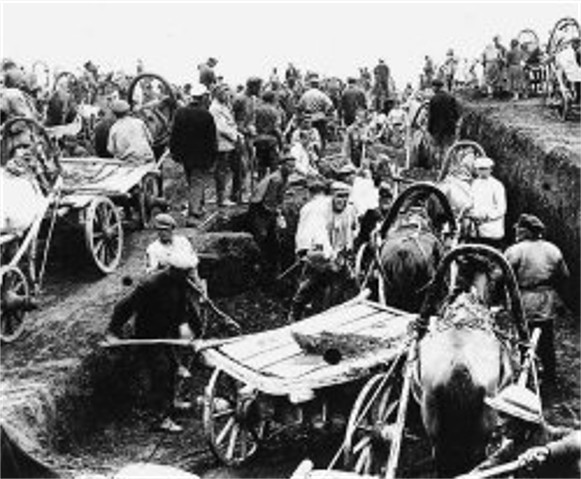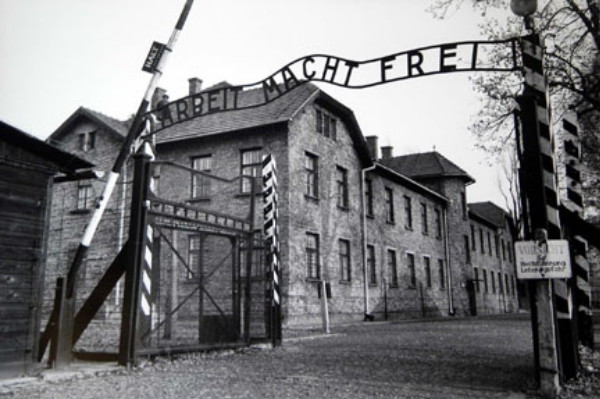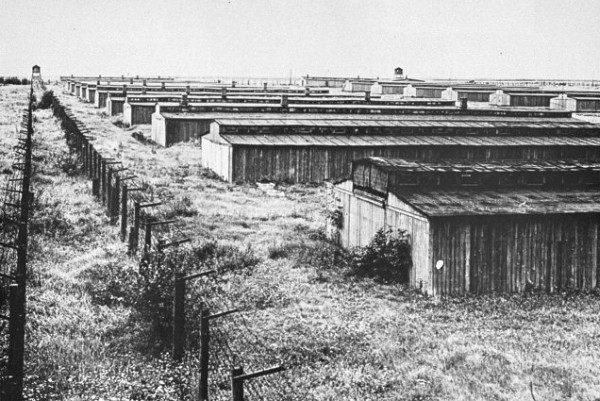Concentration camps
Concentration camps [концентраційні табори; kontsentratsiini tabory]. Confinement centers for civilians, in peacetime or wartime, who are regarded by government authorities to be politically unreliable or undesirable. Along with deprivation of freedom, the concentration camp regime usually includes some form of forced labor.
The first concentration camp in which Ukrainians were incarcerated was the Austrian internment camp in Thalerhof during the First World War, where almost 7,000 Ukrainians accused of Russophilism were confined. As a result of unhygienic conditions and contagious diseases, a large percentage of them died. A much greater number of Ukrainians, 70,000–100,000, were interned in Polish concentration camps at Strzałków, Brest, Wadowice, and Dąbie in 1919–20 after the occupation of Galicia. They included former soldiers of the Ukrainian Galician Army and thousands of civilians accused or suspected of disloyalty. Unsanitary conditions in the camps, poor nourishment, and diseases such as typhus and dysentery caused the death of a large number of internees.
The spread of totalitarian ideas in Poland in the 1930s led to the establishment of a concentration camp in Bereza Kartuzka (1934–9). According to the decree of 18 June 1934 issued by the president of Poland, the administration could incarcerate in this camp individuals who ‘by their activity or behavior gave grounds for suspicion that they endangered public safety, peace, and order.’ Ukrainians who were suspected of belonging to the Organization of Ukrainian Nationalists constituted almost 65 percent of the prisoners. A large number of Ukrainians were sent to Bereza Kartuzka when the Polish-German war (see Second World War) broke out in 1939 (4,500 of 7,000 prisoners).
After the Hungarian occupation of Transcarpathia in 1939, several hundred Ukrainian activists and members of the Carpathian Sich were interned in Hungarian concentration camps in Kryva, near Khust, and Varjú-Lapos, near Nyíregyháza.
Under the Nazi regime in Germany, concentration camps were set up according to the 1933 decree On the Security of the Reich. The camps were under the jurisdiction of the Chief Security Administration of the Reich, headed by Heinrich Himmler, and contained individuals accused of criminal acts as well as political opponents of Nazism. During the Second World War the concentration camps in Germany were greatly expanded and used not only as isolation centers, but also as centers of slave labor and mass extermination, particularly of Jews. Among the larger concentration camps that confined Ukrainians were Dachau, Buchenwald, Oranienburg, Sachsenhausen, Gross-Rosen, Flossenbürg, Oświęcim Concentration Camp (Auschwitz) and Majdanek (both in Poland), Mauthausen (Austria), and Terezín (Czechoslovakia). Smaller concentration camps were found in Ukraine, including Kyiv.
Ukrainians were generally sent to German concentration camps for political reasons. Almost all of these were known or suspected members of the Organization of Ukrainian Nationalists (almost 2,000 people). They were arrested in two waves: in the early fall of 1941 and in mid-January 1944. Workers from central and eastern Ukraine who had been deported to Germany as slave laborers (Ostarbeiter) and had attempted to escape were also incarcerated (close to 14,500 in Auschwitz alone). Hundreds of thousands of Ukrainian soldiers of the Soviet Army died in German prisoner-of-war camps.
Concentration camps in the USSR are officially known as ‘corrective-labor camps’ (ispravitelno-trudovye lageria or ITL). At the beginning of the October Revolution of 1917 Soviet jurisprudence considered retributive punishment for political and criminal misdeeds to be distinct from corrective punishment. The program of the Russian Communist Party (Bolshevik) permitted the substitution of forced labor in corrective-training establishments for the usual deprivation of freedom by imprisonment. This theory was expressed in the Corrective-Labor Code of the Russian SFSR and other Soviet republics. A system of forced-labor camps was introduced by the decrees of the All-Russian Central Executive Committee issued on 15 April 1919 and 17 May 1919. Such camps were to be set up in every gubernia. For more dangerous political prisoners, however, a separate system of labor camps was created on the Solovets Islands in 1920. In accordance with the decree of 26 September 1919, higher state, police, and church officials of tsarist Russia, landowners, nobles, and others were to be sent to the Solovets camps. In 1920–3 the Ukrainians who were incarcerated in these camps consisted mostly of insurgents, particularly the followers of Nestor Makhno. During this time concentration camps were also set up on the Pechora River, where lumbering was the main form of labor, and in Siberia, where gold mining was important. From 1924–5 priests of the Ukrainian Autocephalous Orthodox church, Nepmen, and later kulaks were sent to these camps.
From 1928 to 1934 a huge network of concentration camps was established. The idea of reforming prisoners was replaced by the economic aim of exploiting their labor. The White Sea Canal, the hydroelectric stations on the Svir and Niva rivers in Karelia, the railroad lines Kotlas-Ukhta, Baikal-Amur, etc, were all built by prison labor. The Soviet government did not try to conceal the existence of the forced-labor camps and emphasized that they were a means of re-educating ‘non-working’ and ‘hostile class’ elements through work. Yet, from the mid-1920s prison statistics ceased to be published. In Ukraine the period 1928–34 coincided with the first great wave of terror, the anti-kulak campaign, the collectivization drive, and the Famine-Genocide of 1932–3. Of the over one million victims sent to concentration camps from Ukraine about 70 percent were kulaks, but there were also many intellectuals, writers, and former members of Ukrainian national parties and opposition groups in the Communist Party of Ukraine. The kulaks were usually confined in special concentration camps known as spetsposeleniia (special settlements). In these new or long-established villages located in the north, in Siberia, or in Central Asia, the deported peasants were settled together with released inmates of corrective-labor camps who were prohibited from returning home. Although inhabitants of the special settlements lived under the constant surveillance of the NKVD and were forbidden to leave their settlements, they were not actually imprisoned behind barbed wire and could decide how to make their living.
As early as 1930 the Statute for Corrective-Labor Camps was introduced, and three years later a new Corrective-Labor Code of the RSFSR was adopted, which recognized the camps and the so-called labor colonies as the basic form of imprisonment for petty criminals. Because most concentration camps at the time were located within the RSFSR, they were directly affected by the new code. On 10 June 1934 the infamous GULAG, ie, the Chief Administration of the Corrective-Labor Camps and Labor Settlements, was established within the NKVD. This office was responsible for all the concentration camps except a few local camps that came under the jurisdiction of the People's Commissariat of Justice. Within the GULAG system there were several large territorial administrations, each with 10–20 departments. Each department was responsible for several camps. Before the German-Soviet War the more notorious departments and clusters of concentration camps were Belbaltlag (White Sea-Baltic), Karlag (Karaganda oblast), Dalstroi (Kolyma region), Temnikov camps (Saransk-Potma in the Mordovian ASSR), and Svirstroi (near Leningrad).
The GULAG completed the transformation of concentration camps into economic enterprises using slave labor. According to data published by the International Labor Organization and the Economic and Social Council of the United Nations, 14 percent of the industrial output of the USSR, or 6.8 billion rubles’ worth of production, was produced by forced labor in 1941. These figures include 12 percent of the lumber production, 5 percent of the coal, 2 percent of the oil, 40 percent of the chromium ore, and 77 percent of the gold production of the USSR. Before the Second World War the GULAG’s concentration camps held about 10–12 million prisoners, that is, almost 30 percent of the USSR labor force employed in non-agricultural work.
Most of the prisoners in Soviet concentration camps were political prisoners. During the second wave of Stalinist terror, in 1936–8 (see Yezhov terror), about one million Ukrainian political prisoners, mostly intellectuals or technical or administrative staff, found themselves in the concentration camps. Other prisoners included workers and collective farmers sentenced for petty theft and accidents involving machinery, almost all members of religious sects, foreigners, people with relatives outside the Soviet Union, and finally, speculators, bandits, and hooligans. When the Soviet Army occupied Western Ukraine, Western Belarus, and the Baltic countries, the concentration camps received an influx of nationally conscious elements from these territories. During and after the Second World War individuals sent to concentration camps were generally accused of such crimes as anti-Soviet agitation, praise of bourgeois society, collaboration with the Germans, and participation in or ties with anti-Soviet underground organizations and movements. Many foreigners, mostly prisoners of war and former Communists captured by the Soviets, found themselves in concentration camps. A large number of Ukrainian Catholic clergy were imprisoned.
The severity of the camp regime varied in different periods. In the 1930s camp conditions were made particularly difficult by the lawlessness and arbitrariness of the administrative personnel, which consisted of a large number of convicted criminals. Occurrences of brutality, cruelty, and sadism were frequent. Additional hardship was deliberately imposed by the incarceration of political prisoners with common criminals, who terrorized and exploited the intellectuals. In various years, particularly in 1937, 1938, and 1941, the NKVD is known to have ordered politically dangerous prisoners to be executed. During the waves of executions a large number of prominent Ukrainian cultural and political figures who had been sent to concentration camps in the early 1930s were shot.
Production norms, which determined a prisoner's food rations and other supplies, were always high in the concentration camps and beyond the strength of many prisoners. Prisoners were given a diet intended to do no more than sustain their power to work. Most had the right to correspond with their families and to receive parcels. However, the regime was much more severe in the special isolation camps that contained the most dangerous ‘criminals.’ The extreme climate, lack of the most elementary medical care, and hard labor resulted in a high rate of illness and mortality.
In 1948 all prisoners were reclassified. Special camps with a particularly strict regime were created for those prisoners who had been convicted of participation in or ties with anti-Soviet organizations or undergrounds, espionage, and the most violent criminal acts. On completion of their prison terms these convicts were settled in remote areas and forbidden to return to their families. The special labor camps were under the supervision of the MGB (Ministry of State Security), which had an officer in every camp. The strict regime of the special camps often degenerated into arbitrary rule. Deprived of any legal means of protest and self-defense against the lawlessness of the administration and guards, the prisoners resorted to labor strikes. These strikes were ruthlessly suppressed by all the means at the administration’s disposal, including tanks and machine guns. In 1953 the large uprisings that took place in Vorkuta and Norilsk resulted in many dead and wounded. In 1954 several hundred prisoners, including many women, were killed during the uprising in Kingir, Kazakhstan. These protest actions were led mainly by Ukrainians, who were joined by members of other persecuted nationalities. The special camps contained about 1.5 million prisoners, and all the concentration camps contained over 10 million. Ukrainians constituted the largest group in the prison population, the second-largest was composed of all other non-Russian nationalities, and the third of Russians. Beginning in 1954, the regime of the special camps was tempered, and prisoners were required only to report for work. At the same time the official designation for the prisoners was changed from ‘enemies of the people’ to the ‘temporarily isolated.’
The concentration-camp districts that had large numbers of Ukrainians in 1945–54 (with the special camps in parentheses) included Vorkuta (Rechlag), Inta-Abez (Minlag), Ukhta, Saransk-Potma (Dublag), Omsk (Kamyshlag), Karaganda (Peschlag), Kingir-Dzhezkazgan (Steplag, later annexed to Peschlag), Taishet (Ozerlag), Norilsk (Gorlag), and Kolyma (Bereglag). Furthermore, the great expanses of Asia and northern Russia were settled by deportees from Ukraine. Most of the concentration camps mentioned were located in the northern part of the Soviet Union, within the polar or subpolar zone. Until 1954 concentration camps were also found in the Ukrainian SSR, mainly in the Donbas and the industrial regions of Dnipropetrovsk and Kirovohrad. Their inmates were mostly war prisoners.
After Joseph Stalin’s death there was a radical change in the camp system. At the 20th Congress of the Communist Party of the Soviet Union in 1956 Stalin's thesis that the class struggle would intensify as the USSR approached socialism was rejected, and the thesis that socialism had been achieved in the USSR and that bourgeois relics and hostility to socialism had faded from the popular mind was adopted. As a result, the GULAG system and many concentration camps were ‘officially’ abolished. Prisoners who had less than five years to serve were freed, although many of the released had to remain in the north. The prison terms of some others were shortened.
The forced-labor camps, however, continued to exist and were administered by the MVD (Ministry of Internal Affairs). From the early 1960s the number of political prisoners confined in them was constantly increasing with the rise of the dissident movement, which advocated the upholding of basic human rights, the defense of non-Russian cultures, and freedom of religion.
There were four types of camp regime regulating the conditions of imprisonment: the ordinary, intensified, strict, and special (in order of increasing severity). Each entailed a progressive reduction in prisoners’ rights to visits, correspondence, food rations, etc, and determined the type and amount of labor required. ‘Special regime’ prisoners were kept in cells.
According to Amnesty International, in the mid 1980s, there are over 330 prisons and labor colonies in the USSR known to have confined political prisoners. More than 180 of these were in the RSFSR, 60 were in Ukraine, and the remaining are distributed in other republics. The highest concentration of political prisoners was found in the Mordovian complex (particularly the Dubrovlag subcomplex) in the Mordovian ASSR and in the Perm complex in Perm oblast. Of the approximately 1 million persons imprisoned in the USSR (other sources suggested as many as 2.5 million), about 1 percent were political prisoners. The majority of this minimum figure of 10,000 were confined in concentration camps, and a significant number of them were Ukrainian.
(See also Exile, Penitentiary system, Forced labor.)
BIBLIOGRAPHY
Iurchenko, V. Shliakhamy na Solovky (Lviv 1931)
Bereza Kartuz'ka (Saskatoon, Sask nd)
Dans'kyi, O. Khochu zhyty (Munich 1946)
Martynets', V. Brätz (Stuttgart 1946)
Dallin, D.J.; Nicolaevsky, B.I. Forced Labor in Soviet Russia (New Haven, Conn 1947)
Pidhainyi, S. Ukraïns'ka inteligentsiia na Solovkakh (Munich 1947)
Ianiv, V. Nimets'kyi kontsentratsiinyi tabir (Munich 1948)
Savchenko, V. Bezymlah (Augsburg 1948)
American Federation of Labor. Slave Labor in Russia (Washington, DC 1949)
International Confederation of Free Trade Unions. Stalin's Slave Camps (Brussels 1951)
Margolin, Iu. Puteshestvie v stranu ZeKa (New York 1952)
Prychodko, N. One of the Fifteen Million (Boston 1952)
Ivanov-Razumnik, R. Tiur'my i ssylki (New York 1953)
Pidhainy, S. Islands of Death (Toronto 1953)
United Nations, International Labor Office. Report of the Ad Hoc Committee on Forced Labor (Geneva 1953)
Gerland, B. Die Hölle ist ganz anders (Stuttgart 1954)
Iakovlev, B. Kontsentratsionnye lageri SSSR (Munich 1955)
Scholmer, J. Die Toten kehren zurück (Munich 1955)
Makar, V. Bereza Kartuz'ka (Toronto 1956)
Hrytsak, P. Vezhi i kulemety (Munich 1959)
Bilyns'kyi, A. V kontstaborakh SRSR (1944–55) (Munich 1961)
Solzhenitsyn, A. The Gulag Archipelago, 3 vols (New York 1973-8)
Geller, M. Le monde concentrationnaire et la littérature soviétique (Lausanne 1974)
Amnesty International. Prisoners of Conscience in the USSR: Their Treatment and Conditions (London 1975)
Kostiuk, H. Okaianni roky (Toronto 1977)
Shifrin, A. The First Guide to Prisons and Concentration Camps of the Soviet Union (Toronto–New York–London–Sydney 1982)
Andrii Bilynsky, Vsevolod Holubnychy
[This article originally appeared in the Encyclopedia of Ukraine, vol. 1 (1984).]
.jpg)




 forcedlabor camp.jpg)
